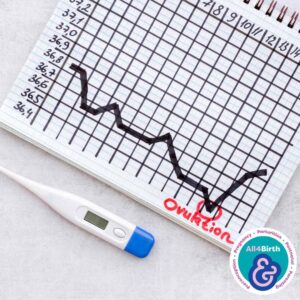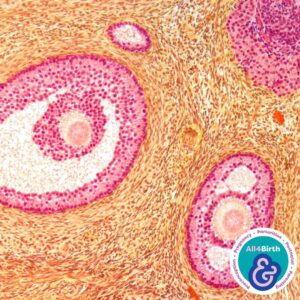Abbie Tomson
Midwife BSc MSc, Yoga Teacher, All4Birth Lead
@enevlorel
Summary
The menstrual cycle is a natural process in women and people of reproductive age. A complex interplay of hormones regulates it and involves the shedding of the uterine lining through vaginal bleeding. A cycle typically lasts between 21 to 35 days and can vary in length and intensity from person to person. The menstrual cycle has four phases: the menstrual phase, the follicular phase, the ovulatory phase, and the luteal phase. Each phase is characterised by different hormonal changes and physical symptoms. Understanding the menstrual cycle can help women track their fertility and identify potential issues or irregularities.
What is ‘the menstrual phase’? 1
The menstrual phase, also known as the menstrual period or simply “period,” is the first phase of the menstrual cycle. It marks the shedding of the uterine lining built up over the previous cycle in preparation for a potential pregnancy. This shedding results in vaginal bleeding that typically lasts between 3 to 7 days, although it can vary from person to person. The menstrual phase is triggered by a decrease in the levels of oestrogen and progesterone hormones, which causes the blood vessels in the uterus to constrict and the lining to break down and be expelled from the body. During this phase, women may experience physical symptoms such as cramping, bloating, and fatigue as the body adjusts to these hormonal changes.
During the menstrual phase, the levels of oestrogen and progesterone drop significantly, signalling the start of the bleeding phase. This drop in hormone levels causes the uterus’s blood vessels to constrict, leading to the breakdown and shedding of the uterine lining. As the lining is shed, it is expelled from the body through the vagina in the form of menstrual blood. The drop in hormone levels also triggers the release of follicle-stimulating hormone (FSH) and luteinising hormone (LH) from the pituitary gland. FSH stimulates the growth of follicles in the ovaries, which produce and release oestrogen. As oestrogen levels rise, they help to rebuild the uterine lining in preparation for a potential pregnancy. The ovaries produce progesterone after ovulation has occurred, and it helps to maintain the uterine lining in the event of pregnancy. If pregnancy does not occur, progesterone levels drop, and the lining is shed during menstruation.
What is typically ‘normal’ in the menstrual phase? 1
Although everybody’s ‘normal’ will differ, it’s important to understand the general underlying physiology of this phase. The menstrual phase typically lasts between 3 and 7 days, although it can vary slightly from woman to woman. The amount of bleeding can also vary, with some women experiencing light bleeding while others may experience heavier bleeding. The colour of the blood can range from bright red to dark brown, depending on how quickly it is expelled from the body. It is common to experience physical symptoms during this phase, such as cramping, bloating, and fatigue, although the severity of these symptoms can vary. While there is no absolute “normal” menstrual phase duration or amount of bleeding, people generally have a good sense of what is normal for their bodies. Any significant changes to the length or intensity of bleeding or the regularity of periods may warrant medical attention, as they may be indicative of a hormonal imbalance or other underlying condition.
Symptoms that may prompt investigation into your menstrual phase
Many signs and symptoms can characterise an abnormal menstrual phase of the menstrual cycle. This is a brief and non-specific list of some common signs of an abnormal menstrual phase:
1. Irregular periods: If the length of the menstrual cycle varies significantly from month to month or periods are missed altogether, it may indicate an underlying hormonal imbalance or other medical condition. 2
2. Heavy bleeding: If bleeding is significantly heavier than usual or lasts longer than seven days, it may indicate a condition such as fibroids, endometriosis, or polyps.
3. Light bleeding: If the bleeding is significantly lighter than usual or lasts for a day or two, it may indicate a hormonal imbalance or other medical condition.
4. Severe pain: If menstrual cramps are severe enough to interfere with daily activities or require medication to manage, it may indicate an underlying condition such as endometriosis. 3, 4
5. Abnormal colour or texture: If the blood is very dark or has an unusual texture, it may indicate a medical condition such as an infection. If any of these signs or symptoms are experienced, it is important to consult a healthcare provider for further evaluation and treatment. 5, 6
Why is an understanding of the menstrual phase important when trying to conceive?
Understanding the menstrual phase is important when trying to conceive because it can help people identify their fertile window – when they are most likely to become pregnant. The fertile window is the period leading up to and including ovulation, which typically occurs in the middle of the menstrual cycle. By tracking the length of their menstrual cycle and the timing of their periods, women can estimate when ovulation is likely to occur and plan intercourse accordingly. This is important because fertilisation occurs only when sperm are present in the reproductive tract during ovulation. Understanding the menstrual phase can help women identify potential issues or irregularities affecting their fertility. For example, irregular periods or absent periods can indicate hormonal imbalances that may make it more difficult to conceive.
Links to other resources
 Articles
Articles
Periods and Fertility in the Menstrual Cycle | NHS
Menstrual Cycle and Getting Pregnant | Tommy’s
 Books
Books
It Starts with an Egg | Rebecca Fett
Taking Charge of Your Fertility | Toni Weschler
 Film Audio
Film Audio
 Websites
Websites
References
- Weschler, T. (2016). Taking Charge of Your Fertility: The Definitive Guide to Natural Birth Control, Pregnancy Achievement, and Reproductive Health. Random House
- Munro MG, Critchley HO, Fraser IS; FIGO Menstrual Disorders Committee. The two FIGO systems for normal and abnormal uterine bleeding symptoms and classification of causes of abnormal uterine bleeding in the reproductive years: 2018 revisions. International Journal of Gynecology & Obstetrics. 2018;143(3):393-408.
- American College of Obstetricians and Gynecologists. (2021). Dysmenorrhea: Painful Periods. https://www.acog.org/womens-health/faqs/dysmenorrhea
- Iacovides, S., Avidon, I., & Baker, F. C. (2015). What we know about primary dysmenorrhea today: a critical review. Human Reproduction Update, 21(6), 762–778
- American College of Obstetricians and Gynecologists. (2018). Abnormal Uterine Bleeding. https://www.acog.org/womens-health/faqs/abnormal-uterine-bleeding
- Mayo Clinic. (2021). Menstrual cycle: What’s normal, what’s not. https://www.mayoclinic.org/healthy-lifestyle/womens-health/in-depth/menstrual-cycle/art-20047186#:~:text=What’s%20typical%3F,last%202%20to%207%20days











